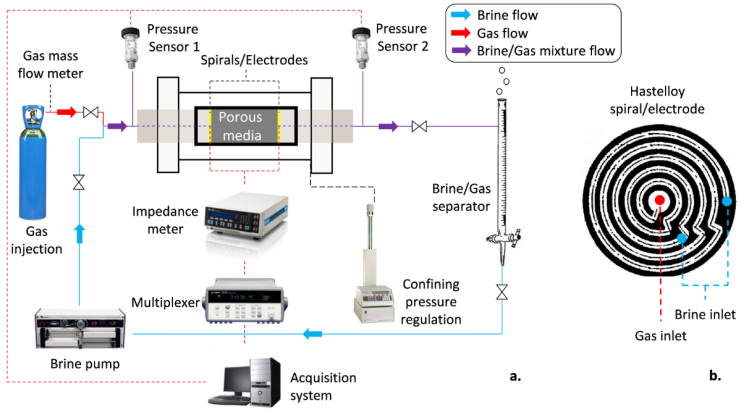19.09.2019
5 minutes of reading
A thesis performed at IFPEN [1] allowed to characterize the impact of a CO2 injection into carbonate rocks, using electrokinetic measurements.
To store CO2 in the ground or underground, it is essential to have an understanding of the evolution of the permeability of the surrounding environment during injection. The methods employed today, such as sample (core) extraction used for characterization in the laboratory, are intrusive, difficult and expensive. Having access to a simple measurement system that can be used directly in the field represents a clear advantage. Such was the objective of a thesis carried out at IFPEN [1], in which a correlation was sought between the relative permeability of the rock and an easily measurable electrokinetic property. The research focused primarily on carbonate reservoirs since, as the environment under consideration for storage purposes, their behavior on contact with CO2 is of vital importance.
Therefore, the thesis examined the impact of a CO2 injection (in a gas and/or liquid form) on the electrical conductivity and electrokinetic properties of carbonate rocks, partially or entirely saturated in water. Two types of polarization methods – spontaneous (passive) and induced (active) – were used, with the initial objective to compare the results obtained here with data from literature. However, the data published today concerns essentially the coupling of “petrophysical-geochemical” aspects with electrokinetic data related mainly to sandstone. The research conducted during this thesis therefore gives a new and exceptional set of reference data for carbonates.
Firstly, the spontaneous polarization method led to determination of the relationships between capillary pressure, relative permeability within the carbonate rocks and the electrokinetic coupling coefficient. The coupling coefficient is a key parameter provided by the method [2], and directly correlated with the degree of water saturation of the sample. For the rocks studied, this relationship was defined using experimental apparatus dedicated to the characterization of water-gas-type two-phase flows (figure below). The apparatus allowed to simultaneously determine the relative permeability, the resistivity index and the electrokinetic coupling coefficient as a function of the sample’s water and carbon dioxide saturation.

The results were compared to theoretical models based on the approaches employed by Brooks and Corey [3] and Van Genuchten [4], using capillary pressure models. They then made it possible to adjust the parameters of the law relating permeability and saturation, a law that is necessary for access to the instantaneous relative permeability from electrokinetic measurements alone.
As for the induced polarization method (with imposed current), it is aimed at eliminating some of the “drawbacks” of the spontaneous method, which limit its use on the ground: weak currents, lower sensitivity and restricted geo-electrical data. More complex but also providing more information, this method provides access to a clearer understanding of the phenomena involved. In our case, it gives the opportunity to determine how the conductivity of water present in the pores of the unsaturated carbonate rocks influenced the various properties of the latter. The results obtained demonstrated that, in reality, the evolution of the parameters measured reflects a double-layer polarization phenomenon when water conductivity lies within a certain range.
* due to the presence of electrical charges close to the surface of the mineral and to other more distant charges, in the inter-pore zone.

Scientific contact: Bruno Garcia
[1] Aurélien Chérubini, 2019. Utilisation des méthodes de polarisation spontanée et polarisation provoquée pour la détection de CO2 en milieu poreux carbonaté. (The use of spontaneous and induced polarization methods for the detection of CO2 in porous carbonate media). Thesis defended on 25 March 2019 at IFPEN Rueil-Malmaison.
[2] Adrian Cérépi, Aurélien Chérubini, Bruno Garcia, Hervé Deschamps, André Revil, 2017. Streaming potential coupling coefficient in unsaturated carbonate rocks. Geophysical Journal International.
[3] Brooks, R.H., and Corey, A.T. (1964). Hydraulic properties of porous media. Hydrology paper N°3, Colorado State University, Fort Collins, Colorado, 22-27.
[4] Van Genuchten, M.T. (1980). A closed-form equation for predicting the hydraulic conductivity of unsaturated soils. Soil Sci. Soc. Am. J., 44, 892-898.





